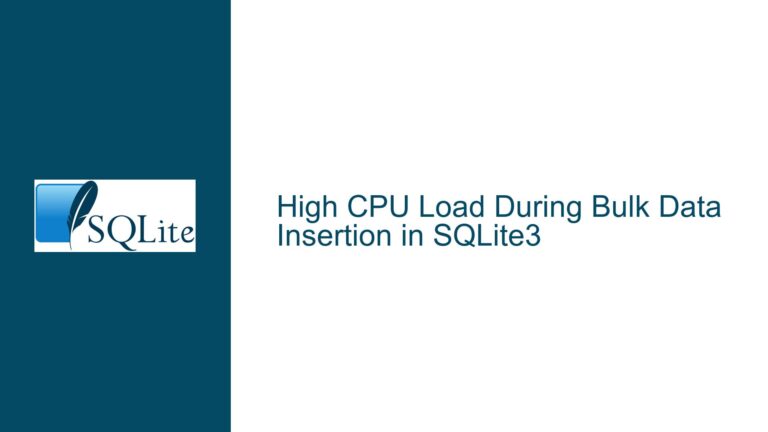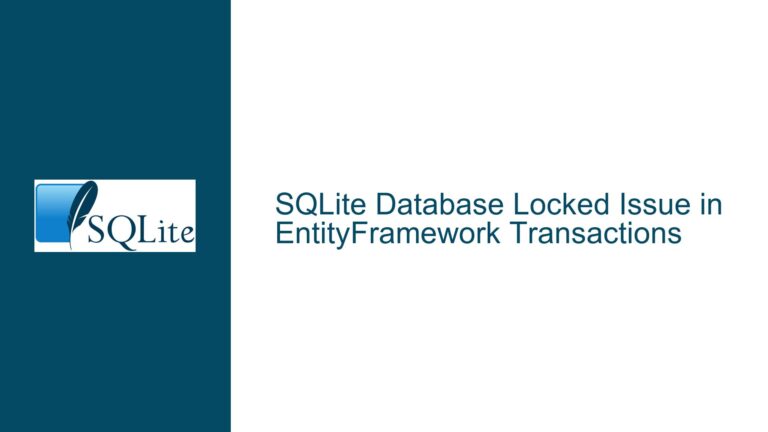Evaluating SQLite FTS Performance for Large-Scale Text Indexing and Search
Understanding SQLite FTS Capabilities, Performance Variables, and Benchmarking Strategies
SQLite FTS Architecture and Performance Expectations
SQLite’s Full-Text Search (FTS) extension is designed for lightweight, embedded text indexing and search use cases. Unlike dedicated search engines such as Lucene, SQLite FTS operates within the constraints of a single-file database architecture. This design choice simplifies deployment but introduces unique performance characteristics.
Core Components of SQLite FTS
- Tokenization: SQLite FTS uses tokenizers (e.g., Unicode61, Porter Stemmer) to break text into searchable units.
- Inverted Indexes: FTS creates virtual tables with inverted indexes optimized for substring and phrase queries.
- Contentless Tables: FTS5 supports contentless tables, where indexed text resides externally, reducing storage duplication.
- Transaction Management: ACID compliance ensures data integrity but imposes write-ahead logging (WAL) or rollback journal overhead.
The indexing process involves parsing text into tokens, building inverted indexes, and committing changes to the database file. Query performance depends on index structure, tokenization rules, and hardware I/O capabilities.
Key Performance Questions
- Indexing Time for 100MB Text Files:
SQLite FTS indexing speed is influenced by tokenization complexity, storage media speed, and write-ahead logging settings. A 100MB text file might take 30–120 seconds on consumer-grade SSDs, but this varies widely with configuration. - Query Latency for 100x100MB Datasets:
Simple term searches can execute in milliseconds, while complex phrase or proximity queries may take longer due to index traversal and result sorting. - Comparison with Lucene:
Lucene’s segment-based indexing and merge policies optimize for high-throughput writes and distributed scaling. SQLite FTS prioritizes transactional safety and simplicity, trading off horizontal scalability. - Viability as a Search Engine Alternative:
SQLite FTS is suitable for applications requiring embedded search with moderate concurrency. It struggles with high write volumes (e.g., real-time indexing) and multi-terabyte datasets due to single-file architecture.
Hardware, Configuration, and Use Case Constraints Affecting SQLite FTS
Hardware Limitations and I/O Bottlenecks
SQLite’s performance is tightly coupled with hardware capabilities:
- Storage Media: NVMe SSDs reduce indexing time by 5–10x compared to HDDs.
- Memory Allocation: The
page_sizeandcache_sizepragmas determine how much data is cached in RAM. Insufficient caching forces frequent disk reads. - CPU and Tokenization Overhead: Complex tokenizers (e.g., ICU) increase CPU load during indexing.
SQLite Configuration Parameters
- WAL Mode: Enabling WAL (
PRAGMA journal_mode=WAL) allows concurrent reads/writes but may slow bulk inserts due to checkpointing. - Synchronous Settings:
PRAGMA synchronous=OFFdisables immediate disk flushes, speeding up writes at the risk of data loss. - Contentless vs. Content Tables: Contentless tables (FTS5) reduce storage overhead but require external content management, adding complexity to queries.
Architectural Trade-offs vs. Dedicated Search Engines
- Single-File Bottleneck: Concurrent writes are serialized, limiting throughput in high-concurrency environments.
- Lack of Distributed Indexing: SQLite cannot shard indexes across multiple nodes, unlike Elasticsearch or Solr.
- Limited Relevance Scoring: FTS ranking algorithms (e.g., BM25) are simpler than Lucene’s TF-IDF or learning-to-rank models.
Benchmarking, Optimization, and Decision-Making Workflows
Step 1: Establish a Controlled Benchmarking Environment
- Hardware Baseline:
- Use a system with NVMe storage, 16+ GB RAM, and a modern CPU.
- Isolate the test environment from network/background processes.
- Dataset Preparation:
- Generate representative text corpora (e.g., 100x100MB files with mixed-term distributions).
- Preprocess text to match tokenizer rules (e.g., normalize Unicode, remove stop words).
- SQLite Configuration:
PRAGMA page_size = 4096; PRAGMA cache_size = -1000000; -- 1GB cache PRAGMA journal_mode = WAL; PRAGMA synchronous = NORMAL;
Step 2: Implement Custom FTS Benchmarks
- Indexing Workload:
Measure time to create FTS tables with varying parameters:CREATE VIRTUAL TABLE fts_demo USING fts5(content, tokenize='unicode61'); -- Insert 100MB of textCompare
contentless=1vs. standard tables. - Query Workload:
Execute search queries with realistic term frequencies:SELECT * FROM fts_demo WHERE content MATCH '"Capture latency for exact terms, wildcards, and NEAR queries.
Step 3: Analyze and Optimize
- Identify Bottlenecks:
- Use
EXPLAIN QUERY PLANto audit index usage. - Profile I/O with tools like
iotopor SQLite’ssqlite3_stmt_status().
- Use
- Parameter Tuning:
- Adjust
mmap_sizeto leverage memory-mapped I/O. - Experiment with tokenizers (e.g.,
porterfor stemming).
- Adjust
- Concurrency Testing:
Simulate multiple clients with tools likesqlite3_multithreador custom scripts.
Step 4: Compare with Lucene and Alternatives
- Indexing Throughput:
Lucene typically indexes 20–50 MB/sec on similar hardware, outperforming SQLite FTS in bulk ingestion. - Query Features:
Evaluate advanced requirements (e.g., faceting, geospatial search) unsupported by SQLite. - Operational Complexity:
Assess deployment trade-offs: SQLite requires no server setup, while Lucene demands JVM tuning and cluster management.
Final Recommendations
- Adopt SQLite FTS If:
- Embedded deployment and ACID compliance are critical.
- Dataset size is <1TB, and write concurrency is low.
- Choose Lucene/Solr If:
- Scaling beyond a single node or handling real-time updates is required.
- Advanced ranking and query flexibility are needed.
SQLite FTS excels in niche scenarios but requires rigorous benchmarking to validate its fit. Use the LumoSQL benchmarking suite to automate cross-version and cross-configuration testing, and contribute results to community-driven performance databases.






